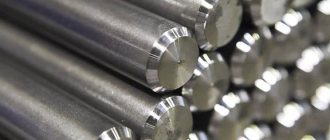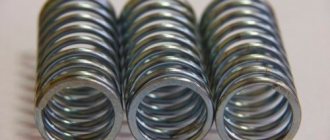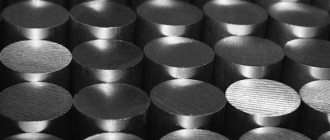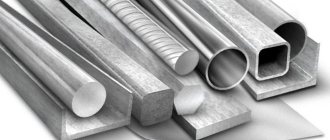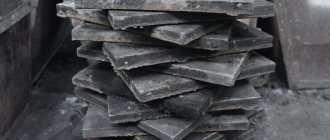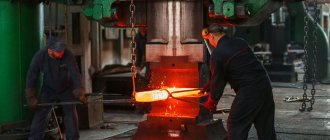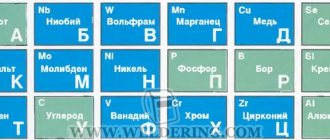Variety of low carbon steels
Low-carbon alloys contain impurities of various types. Increased sulfur and phosphorus content directly affect the properties of the metal and can lead to cracking during processing. Manganese and silicon do not reduce characteristics; they participate in the process of deoxidation and oxygen removal. Oxygen is removed to increase the strength of the material during hot deformation.
According to the degree of oxygen removal and deoxidation, steel is classified into:
- boiling;
- calm;
- semi-calm.
Low-alloy steels are an alloy with a low carbon content and small amounts of alloying additives, a total ratio of up to 4%. Alloying elements are needed to increase any performance properties while maintaining good welding characteristics. Increased resistance of the metal to corrosion and the ability to work at extremely low and high temperatures without deformation is achieved by alloying.
The quality of low-carbon steel is determined by the content of sulfur and phosphorus impurities in the alloy.
Based on the type of properties, they are distinguished:
- Usual quality. Sulfur in the composition - up to 0.06%, phosphorus - up to 0.07%.
- High quality steel. Mass fraction of sulfur - up to 0.04%, phosphorus - up to 0.035%.
- High quality steel. Sulfur content - up to 0.025%, phosphorus - up to 0.025%.
- Special quality. Minimum presence of impurities: permissible values of sulfur - up to 0.015%, phosphorus - up to 0.025%.
Classification by degree of deoxidation
The division of carbon steels into various types is influenced, among other things, by such a parameter as the degree of deoxidation. Depending on this parameter, carbon steel alloys are divided into calm, semi-calm and boiling.
Quiet steels have a more homogeneous internal structure, the deoxidation of which is carried out by adding ferrosilicon, ferromanganese and aluminum to the molten metal. Due to the fact that the alloys of this category were completely deoxidized in the furnace, their composition does not contain ferrous oxide. Residual aluminum, which inhibits grain growth, gives such steels a fine-grained structure. The combination of a fine-grained structure and the almost complete absence of dissolved gases allows the formation of high-quality metal from which the most critical parts and structures can be made. Along with all their advantages, carbon steel alloys of the quiet category also have one significant drawback - their smelting is quite expensive.
The structure of a steel ingot depends on the degree of deoxidation of the steel
Cheaper, but also of lower quality, are boiling carbon alloys, the smelting of which uses a minimum amount of special additives. In the internal structure of such steel, due to the fact that the process of its deoxidation in the furnace was not completed, there are dissolved gases that negatively affect the characteristics of the metal. Thus, the nitrogen contained in such steels has a bad effect on their weldability, provoking the formation of cracks in the weld area. The developed segregation in the structure of these steel alloys leads to the fact that the rolled metal that is made from them has heterogeneity both in its structure and in its mechanical characteristics.
Semi-quiet steels occupy an intermediate position both in their properties and in the degree of deoxidation. Before pouring into molds, a small amount of deoxidizing agents is introduced into their composition, due to which the metal hardens practically without boiling, but the process of gas evolution in it continues. As a result, a casting is formed, the structure of which contains fewer gas bubbles than in boiling steels. Such internal pores are almost completely welded during the subsequent rolling of the metal. Most semi-mild carbon steels are used as structural materials.
You can familiarize yourself with all GOST requirements for carbon steel by downloading this document in pdf format from the link below.
Download GOST 380-2005 Carbon steel of ordinary quality. Stamps
Classification of regular quality steel
Properties of ordinary quality steels
Within the quality group, low-carbon steel of ordinary quality is further divided into three categories, designated by capital letters A, B, C.
Low-carbon steel of ordinary quality of group “A” contains alloys that differ in mechanical properties, and is found in industry in the form of sheet, profile low-carbon rolled products.
Group “B” is classified according to chemical qualities, processed under pressure under high heat, blanks are stamped and forged.
Low-carbon steels of group “B” are determined by their physical properties and chemical composition.
In what areas is carbon steel used?
Due to their high strength, good machinability, durability and comparative cheapness, carbon steels have found their use in many sectors of the national economy.
They are especially popular in mechanical engineering, which is due to the ability of the metal to resist active loads, as well as high fatigue limits. Thus, carbon steel acts as the main material for the production of:
- flywheels;
- gears of reducers;
- connecting rod bodies;
- crankshafts;
- plunger pump pistons.
Carbon alloys are used to produce technological equipment for the light woodworking industry. In all these cases, structural carbon steels are used. After carburization, this type of metal is used to create wear-resistant parts, the operation of which will be accompanied by significant dynamic loads.
Based on low and medium carbon steel, the following products are produced:
- corners;
- channels;
- pipes;
- I-beams and other profiles
The initial properties of structural carbon steels must be increased by heat treatment (hardening).
The production of tools for various purposes is based on the use of tool steel alloys that contain 0.65–1.32% carbon:
- hammers, cores, screwdrivers, chisels, forging tools, scythes (grade of tool carbon steel U7 and U7A);
- scissors, chipper knives, hand carpentry tools, frame saws (grade U8, U8A);
- drills, small-diameter cutters, band saws, reamers (grade U10, U10A);
- turning wood cutters, hacksaw blades for metal, files, engraving tools (grade U12, U13).
Tool carbon steels are used for the production of measuring instruments. To obtain a small part with a linear dimensional accuracy of several hundred millimeters, the workpiece must not be heated or deformed as a result of the pressure exerted by the cutting tool.
The use of carbon steels of ordinary quality is in demand in construction; some grades are used in mechanical engineering and shipbuilding.
The main methods for producing low-carbon alloys
When produced, all alloys undergo the same technological stages and additional processing. The melting furnace is loaded with raw materials, charge, heated until melted, and excess impurities are removed. Additional processing depends on the specific composition of the product, the desired chemical and physical properties.
According to production technology and equipment, alloys are obtained:
- oxygen-converter smelting method;
- open-hearth method of production;
- electrothermal production method.
Oxygen-converter method
This method of producing a low-carbon alloy is named after two components of the technology. Oxygen in the air oxidizes excess carbon and impurities in the converter furnace. The converter furnace has a volume of 50–60 tons. The molten raw materials, the charge, are blown with heated oxygen under pressure. The convector walls are pear-shaped and made of metal with additional lining. The lining material chemically participates in the smelting process, reacting with the molten raw material.
Open hearth method
Open hearth furnaces are distinguished by the large size of their melting baths, with a capacity of up to 500 tons of products.
The burning of carbon and impurities also occurs with oxygen, but oxygen is obtained not only from the air. Additionally, the charge is enriched with iron ore and scrap covered with rust. Iron oxides, participating in the process, release oxygen. Regenerator chambers preheat the combustible gas and air and alternately release the contents through the melting bath. The process takes place over 6–7 hours; upon completion, heating is stopped and deoxidizing agents are added.
Electrothermal method
This method allows you to obtain precisely specified physical and chemical properties; it is used only for the production of high-quality alloys. The large energy consumption during heat treatment, up to 800 kW per 1 ton of steel, must be economically justified. The oven temperature reaches 1650 degrees, the bath capacity is 0.5–180 tons.
At high temperatures, sulfur and phosphorus are removed almost completely, and refractory raw materials are melted. Chemical reactions during production are similar to the open-hearth method.
Production methods and quality division
Various technologies are used for the production of carbon steels, which affects their division not only by production method, but also by quality characteristics. So, they distinguish:
- high quality steel alloys;
- high-quality carbon steels;
- carbon steel alloys of ordinary quality.
Classification of carbon steels
Steel alloys of ordinary quality are smelted in open-hearth furnaces, after which they are formed into large ingots. Melting equipment used to produce such steels also includes oxygen converters. Compared to high-quality steel alloys, the steels in question may have a higher content of harmful impurities, which affects the cost of their production, as well as their characteristics.
Formed and completely solidified metal ingots are subjected to further rolling, which can be done in a hot or cold state. The hot rolling method produces shaped and sectioned products, thick and thin sheet metal, and large-width metal strips. Cold rolling produces thin sheet metal.
Modern enterprises use electric arc furnaces to produce high-quality alloys
To produce carbon steels of high-quality and high-quality categories, both converters and open-hearth furnaces, as well as more modern equipment - melting furnaces powered by electricity, can be used. The corresponding GOST imposes very stringent requirements on the chemical composition of such steels and the presence of harmful and non-metallic impurities in their structure. For example, steels classified as high-quality should contain no more than 0.04% sulfur and no more than 0.035% phosphorus. Due to the strict requirements for their production method and characteristics, high-quality and high-quality steel alloys are distinguished by increased structural purity.
The main properties of low-carbon steels
Low-carbon steel is characterized by low strength with significant toughness and ductility. The alloy is easily processed by hot deformation, cold drawing, and welds well.
An increase in strength characteristics is achieved by carburization - saturation of the surface layers with carbon, after which the surface layers of the alloy are hardened, acquiring the necessary strength. Induction and electric furnaces are used for surface hardening of low-alloy steel. The inner, not enriched, layers remain soft, viscous, and do not lose plasticity due to the unchanged amount of carbon.
Rusting and stainless steels
The Iron Age began in the 9th–7th centuries BC and lasted until the 1st century AD. Then in China they mastered the primitive production of cast iron - an alloy of iron and carbon. In Europe and Russia, iron production does not begin until the 14th and 16th centuries, respectively. And the production of more or less high-quality high-carbon steel has become possible only in the last 200 years.
At first, mild steel was used everywhere. Before the advent of high-carbon steel, weapon blades were deliberately made thicker to increase strength, and the edge had to be sharpened frequently. For those who worked in the field, a whetstone was a must for everyday carry. The blade could not be counted on to remain sharp for long periods of time.
High carbon steel was the first type of steel that actually had some serious advantages. This greatly influenced both the design of tools and their use. Armies that gained access to high-carbon steel had a significant advantage over enemies that had not yet obtained such steel. Carbon steel has significantly changed the steel world.
An early example of high carbon steel was the famous Damascus steel . The production of Damascus was a serious secret passed from master to apprentice. Eventually the secret of true Damascus steel was lost around 1750. We'll talk about this another time.
Of course, since then people have developed not only Damascus, but also learned to use other methods to create high-carbon steel.
Making a Damascus steel sword in Syria
What is high carbon steel?
Carbon steel is an alloy of iron and carbon. Technically, steel becomes high carbon when the carbon content exceeds 0.55%. The carbon content can be as high as 3.4%, but this is more difficult and expensive to produce. Therefore, most often high carbon steel will contain between 0.55 and 1% carbon.
Historically, the phrase "high carbon steel" was used specifically to refer to non-stainless steel with a high carbon content. However, modern stainless steels can have the same percentage of carbon content as non-stainless steel. Today in the knife industry, almost all steel is high carbon, with some exceptions such as throwing knives . To this day, many people use the term "high carbon steel" to refer to non-stainless steel, so it is important to be able to define terms when discussing types of steel.
High carbon NOT stainless steel
Mora Pro C Knife
As we mentioned above, high carbon steel contains iron and at least 0.55% carbon. Other metals may be added to improve various properties. The downside of carbon steel is that it is very vulnerable to rust - which is why many carbon steel blades have special coatings to prevent rust. If you do not provide knives with such steel with proper care, rust can ruin the blade and completely corrode the steel.
History of stainless steel
Throughout the 1800s, scientists and industrialists from Britain, France and Germany contributed to the development of stainless steel. Observations and experiments for the possible improvement of steel were noted as early as 1820 by scientists Michael Faraday and Pierre Berthier . They noted the ability of the chromium-iron alloy to resist acid corrosion. Because scientists did not yet know the role of low carbon content, they were unable to produce an alloy with a high chromium content.
One of the most notable roles in this was played by Harry Brearley from the English city of Sheffield. This is not surprising as cutlery has been produced in Sheffield since the sixteenth century. Brearley was appointed lead researcher at Brown Firth's laboratories in 1908, and sometime between 1910 and 1914 he created a steel with so much chromium that it could be considered stainless. The date varies from source to source.
Harry Brearley
Brearley originally called the alloy his Rustless Steel, but his colleague Ernest Stewart suggested Stainless Steel , and the name stuck.
This steel was used to make table knives that should not rust. Unfortunately, although the knives were rust resistant, they did not cut as well as one would hope. And Brearley soon earned a reputation as the inventor of the "knife that doesn't cut . This alloy was used to make table knives for 50 years before metallurgists learned to make stainless steel that would hold an edge long enough.
It was only in the 1960s that high-carbon stainless steel began to be used in the production of Swiss Army knives. They were soon followed by the American Schrade , and then by every other knife company in the United States.
Victorinox 0.8201.26 Pioneer 93 mm
Over time, humanity's knowledge of chemistry and chemical bonds increased, better microscopes were invented, and we began to better understand steel. Metallurgy has improved significantly over the past few decades. And now it has become possible to create fantastic high-carbon and at the same time stainless steels that hold a cutting edge perfectly.
High carbon stainless steel
Research has shown that when steel contains at least 10% chromium (Cr), it protects the steel from corrosion. Free chromium is attracted to and combines with oxygen molecules, forming a protective layer on the surface of the steel. This layer prevents oxygen (O) from reacting with iron (Fe) to form rust (Fe2O). Fortunately, this layer is self-healing when scratched, cut or dents occur. Stainless steel is also resistant to corrosion when exposed to many acids. We wrote about this in more detail in a separate article.
Severe corrosion on the knife blade
The main issues that manufacturers face when making high carbon stainless steel are carbon content, tempering and chromium content. The carbon content strengthens the steel, so if too much is added, the alloy becomes brittle. If manufacturers use too little carbon, there is not enough carbon to strengthen the steel. Chromium content can also have a huge impact on the final product. Chromium is attracted to carbon, meaning that carbon can "steal" chromium from the overall alloy. When this happens, the blade becomes less resistant to corrosion than it should be. Improper quenching and tempering can also make the blade very brittle. High carbon stainless steel typically has fairly poor resistance to heat and may become too brittle to use.
High carbon stainless steel is an alloy containing iron, at least 0.55% carbon and at least 13% chromium. This makes D2 steel, for example, technically not stainless steel, as it typically contains between 11% and just under 13% chromium.
Conclusion
It happens that people buy a knife made of carbon stainless steel, and two weeks later they bring it back because the blade became stained after cutting fruit, or the knife was left (of course briefly and accidentally) in water, and for some reason(!) it started rust.
There are different steels for different jobs. After purchasing any stainless steel knife, you shouldn’t cover the blade with lemon slices, then leave it in the sink overnight, and then sincerely wonder why the knife is rusty, because the steel is stainless! If, for example, you spend a lot of time at sea, you should take a closer look at knives made from H1 steel.
Steels with high carbon content require proper care - that's a fact. But at the same time, blades with such steels dull much more slowly and have a more aggressive cut. Everyone decides for themselves what is important to them.
In our section dedicated to knives, there is a special filter - blade material , where you can select the steel you need and even read its description by clicking on the small question mark.
Marking of low-carbon steels and its meaning
Low-carbon steel of ordinary quality is marked with the letter value “St”, which varies according to the qualities:
- The digital value shows the amount of carbon in the alloy. Dividing the value by 100 gives the carbon content as a percentage.
- The initial letter symbols of the marking “B” or “C” indicate membership in the quality group.
- The absence of a letter designation indicates that it belongs to category “A”.
- The combination “KP” indicates a boiling composition due to deoxidation.
- The combination “PS” indicates a semi-quiet alloy; the absence of a designation indicates a calm steel.
- The letter and number combination written last on the stamp indicates the presence of impurities in the composition and their percentage.
- High-quality low-carbon alloys are not marked with the letter combination “St”.
Additionally, there is a classification by color and letter marking of special-purpose alloys. For example, the marking “STZ bridge” indicates an alloy intended for use in the manufacture of bridge structures.
Pros and cons of cold rolled steel
Cold rolled steel has many advantages. The main advantage of this method is that cold rolled steel is approximately 20% stronger than its hot rolled counterpart. Using heat to roll steel weakens the metal. If high temperatures are not used, steel retains its strength. Thus, anything that contains cold-rolled steel parts tends to last longer than something that contains parts of its hot-rolled counterpart. Another advantage of cold rolled steel is its appearance. It looks modern and finished, unlike its hot-rolled counterpart, which often looks ragged. But all this comes at a price.
The only disadvantage of cold rolled steel is that it costs more than hot rolled steel.
Scope of application
Low-carbon alloys are widely used in various areas of industry and production.
The following groups of products are classified by profile type:
- Flat sheet metal. Corrugated, thick-sheet, thin-sheet, wide-strip, strip products.
- Equal and unequal corner profiles.
- Channels.
- Pipes, round, square, rectangular section.
- Tauris, I-beams. I-beams, wide flange, ordinary.
- Profiled metal sheet of various thicknesses.
The largest product segment is flat rolled sheets and strips. Cold stamping produces high-strength wire, springs, springs for mechanical engineering. Parts and workpieces are easily welded and are widely used in the construction industry and the automotive industry. Low-carbon alloys are used to make body parts, axles, fuel tanks, agricultural machine frames and many other parts that are constantly encountered in everyday life.
Use of cold rolled steel
The main disadvantage of cold rolling is the limited shapes. Cold rolled steel products are usually round, square or flat. There are other forms, but they are just variations of the forms mentioned earlier. Cold rolling also limits the size of the finished product, unlike the hot rolling process.
Typical cold rolled products include rod, rod, sheet and strip. Cold rolled steel, being extremely ductile, is usually used for moderate drawing. This makes them extremely useful for projects where accuracy is important. Cold rolled steel is very ductile. It is used for metal equipment, as well as for metal furniture. It is also often used to make school lockers or garages, industrial buildings and steel sheds. The interior and exterior parts of vehicles are also made from cold rolled steel.
Manufactured products
There are several groups of steel products:
- Sheet steel. Subtypes: thick-sheet (GOST 19903-74), thin-sheet (GOST 19904-74), wide-sheet (GOST 8200-70), strip (GOST 103-76), corrugated (GOST 8568-78)
- Angle profiles. Equal flanges (GOST 8509-93), unequal flanges (GOST 8510-86).
- Channels (GOST 8240-93).
- I-beams. Ordinary I-beams (GOST 8239-89), wide-flange I-beams (GOST 26020-83, STO ASChM 20-93).
- Pipes.
- Profiled flooring.
Secondary profiles are added to this list, which are formed through welding and machining.
Welding Features
Welding low-carbon steels has high performance. The type of welding, electrodes and their thickness are selected based on the following technical data:
- The connection must be firmly fastened.
- There should be no seam defects.
- The chemical composition of the seam must be carried out in accordance with the standards specified in GOST.
- Welded joints must comply with operating conditions (resistance to vibration, mechanical stress, temperature conditions).
Various types of welding can be used, from gas welding to carbon dioxide welding with a consumable electrode. When selecting, take into account the high fusibility of low-carbon and low-alloy alloys.
As for the specific scope of application, low-carbon rolled products are used in construction and mechanical engineering.
So, we found out what products made from low-carbon and low-alloy steel are.
Source of the article: https://fb.ru/article/266192/nizkouglerodistaya-stal-sostav-i-svoystva
Marking features
Ordinary low-carbon steel has a letter designation ST and a number. The number should be divided by 100, then the percentage of carbon will be clear. For example, ST15 (carbon 0.15%).
Let's look at the markings and decipher the notation:
- The first letters or their absence indicate belonging to one or another quality group. It can be B or C. If there is no letter, then the alloy belongs to category A.
- St stands for the word "steel".
- The digital designation is an encrypted percentage of carbon content.
- kp, ps – denotes a boiling or semi-quiet alloy. The absence of a designation indicates that the steel is calm (sp).
- The letter designation and the number after it reveal what impurities are included in the composition and their percentage. For example, G – manganese, Y – aluminum, F – vanadium.
